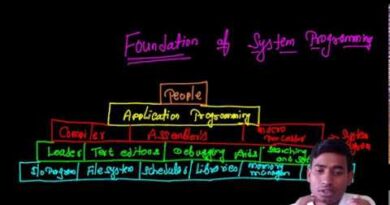System Programming: System Programming Tutorial-concept of assembly language-Assembler and it’s working with diagram
System Programming: System Programming Tutorial-concept of assembly language-Assembler and it’s working with diagram.
Contents [hide]
- 1 System Programming: Assembly Language and Assembler
- 2 1. Introduction to Assembly Language
- 3 Features of Assembly Language
- 4 2. What is an Assembler?
- 5 Assembler Functions:
- 6 3. Working of an Assembler (With Diagram)
- 7 Step-by-Step Assembler Workflow:
- 8 Diagram: Working of an Assembler
- 9 4. Types of Assemblers
- 10 1. Single-Pass Assembler
- 11 2. Two-Pass Assembler
- 12 5. Conclusion
- 13 System Programming: System Programming Tutorial-concept of assembly language-Assembler and it’s working with diagram
- 14 The Art of Assembly Language
- 15 Unit 1 What is System Programming?
System Programming: Assembly Language and Assembler
1. Introduction to Assembly Language
Assembly Language is a low-level programming language that provides a direct mapping to a computer’s machine code. It is written using mnemonics instead of binary opcodes, making it easier for humans to read and write.
Features of Assembly Language
Uses symbolic mnemonics (e.g., MOV, ADD, SUB).
Provides direct hardware control.
Faster execution compared to high-level languages.
Requires an Assembler to convert it into machine code.
2. What is an Assembler?
An Assembler is a system program that translates assembly language into machine code (binary form) that a computer’s CPU can execute.
Assembler Functions:
- Converts mnemonics into opcodes (e.g.,
MOV A, B→78H). - Allocates memory for instructions and data.
- Handles labels and addresses (symbol table management).
- Detects syntax errors in the assembly code.
3. Working of an Assembler (With Diagram)
Step-by-Step Assembler Workflow:
-
Input: Assembly Program
- Programmer writes instructions using mnemonics.
- Example code:
-
Lexical Analysis
- The assembler scans the program and extracts mnemonics, labels, and operands.
-
Syntax Analysis
- Checks for errors like invalid mnemonics or incorrect operand usage.
-
Symbol Table Generation
- Creates a table of labels and their corresponding addresses.
-
Opcode Conversion
- Converts mnemonics into machine code instructions.
-
Address Resolution
- Assigns memory addresses to instructions and data.
-
Output: Machine Code (Object File)
- Generates an executable binary code.
Diagram: Working of an Assembler
4. Types of Assemblers
1. Single-Pass Assembler
- Processes code in one scan.
- Fast but struggles with forward references.
- Example: Basic 8-bit microcontrollers.
2. Two-Pass Assembler
- Pass 1: Creates a symbol table.
- Pass 2: Converts mnemonics to machine code using the symbol table.
- Example: Intel 8086 assembler.
5. Conclusion
- Assembly Language provides direct hardware control and efficient execution.
- Assemblers translate it into machine code using symbol tables, opcode conversion, and address resolution.
- Multi-pass assemblers handle forward references more efficiently.
Would you like a real-world example of an assembly program and its machine code conversion?


